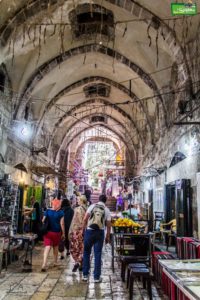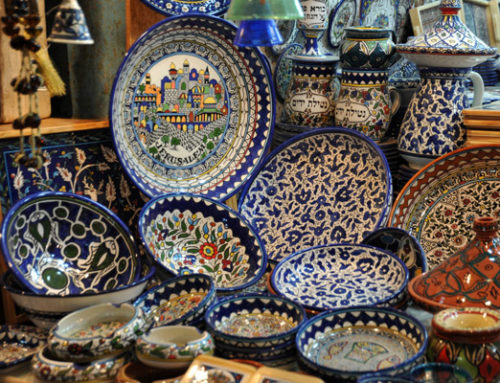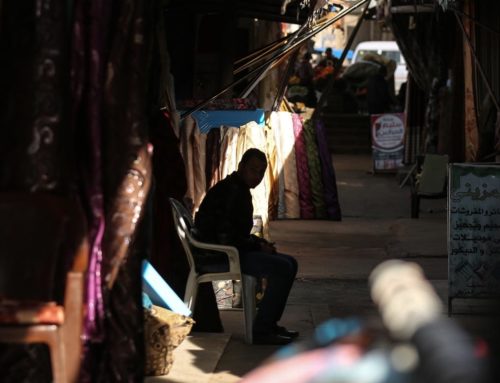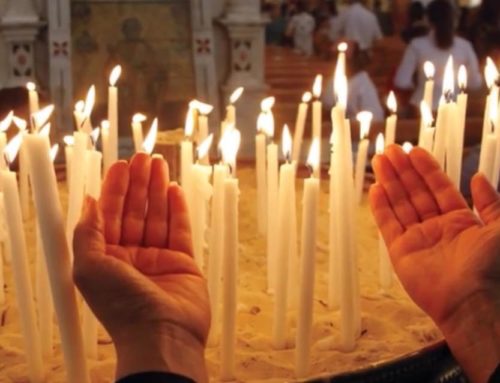History and Location
Cotton Merchants’ Market, known in Arabic as Souq Al-Qattanin, is located within the walls of the Old City of Jerusalem. It starts with the Valley Road, one of the main streets in the Old City, and leads directly to the Aqsa Plaza.[1]
The market was built in different historical eras, as some archeological excavations show that it was active in the Crusaders’ era, while others show that the market was built in the Islamic Mamluk era. Some excavations even date it back to the Fatimid period in Jerusalem. [2]It is believed, therefore, that the market in its current shape dates back to 1329, when Damascus Prince Tankiz Nasser ordered for its establishment during the reign of Mamluk Sultan Mohammed bin Qalawun. .[3]

Architecture
The market, which looks similar to Damascus markets, is considered the most beautiful market in Jerusalem. The construction of it took 7 years and resulted in an architectural masterpiece. Its eastern entrance is one of Al-Aqsa Gates with a height of 6 meters and unique decoration.[4]Creswell, Islamic architecture expert, considers it the most beautiful market in the Levant.[5]
With a length of 95 meters,[6]the market has between 50 to 60 shops. Each shop has a second floor which was used to house religious figures in the city. Currently, the rooms are owned by the Islamic Endowment in the city and manned by Jerusalemite families.[7]
In the fifteenth century, an earthquake destroyed the upper level of some of the market and. as a result, that area has not been used since .[8]

Origins of the Name
The current name of the market, the Cotton Merchants’ Market, was used during the Ottoman Empire era. The name is derived from the famous Egyptian cotton that was manufactured in its shops and then exported worldwide.[9] Currently, the market is known for the sales of diverse products, with a focus on souvenirs for tourists and visitors.[10]
The market is also called the Dark Market (Souq Al-Atem) due to its weak lighting, as sunlight can only enter from six openings in the ceiling.[11]
Famous Landmarks
The market has, in addition to its shops and rooms, a motel and two famous baths: Al-Shifaa, and Al-Ain.[12] The motel was used to host merchants coming from Egypt and Syria in the olden days. Currently, it hosts the Center for Jerusalem Studies associated with Jerusalem University.[13]The two baths, on the other hand, played a key role in the Jerusalemite history and traditions, where the Arab grooms used to be celebrated before the revelers head to Al-Aqsa Mosque to pray .[14] Unfortunately, both baths are currently closed. [15]
Israeli Policy
Israeli forces in Jerusalem have caused the market to recess due to its policies. In addition to the permanent blockade in the middle of the market where the Israeli forces do not allow tourists and visitors to go beyond, Israeli police often block the eastern entrance of the market, which is also a gate of Al-Aqsa, causing worshippers to use other entrances, avoiding the market in the process.[16] This happens regularly on a monthly basis when settlers march to Al-Aqsa to pray and use the gate which they call “the Temple Gate” to enter. During these times, Israeli police forces mandate that the merchants close their shops.[17] Sometimes, however, these occurrences are unscheduled and unplanned and occur often on an irregular basis. As a result, there is great economic disparity, as some merchants make no more than $1.13 a day .[18]
Permanently, Jewish settlers have taken over two of the upper rooms of the market from the northern side and many Palestinian houses next to the market from the southern side.[19] To hasten the cleansing of merchants from the city, harsh taxes and fees are imposed upon the merchants that remain in the marketplace.[20]
[1]“Cotton Merchants’ Market Jerusalem,” at http://www.enjoyjerusalem.com/ar/explore/where-to-go/سوق-القطانين
[2] Palestinian National Authority Ministry of Information, Al-Quds Sights and Landmarks (2015),p 56
[3] “Cotton Merchants’ Market in Jerusalem longs to its Past,” at https://www.aljazeera.net/news/alquds/2016/7/30/سوق-القطّانين-بالقدس-يحن-إلى-ماضيه posted July 30, 2016 and Cotton Merchants’ Market Jerusalem
[4] Cotton Merchants’ Market in Jerusalem longs to its Past
[5]Cotton Merchants’ Market Jerusalem
[6] Id
[7] Cotton Merchants’ Market in Jerusalem longs to its Past
[8] Id
[9] Jerusalem neighborhoods p 57 and Cotton Merchants’ Market in Jerusalem longs to its Past
[10] Cotton Merchants’ Market Jerusalem
[11] Cotton Merchants’ Market in Jerusalem longs to its Past
[12] Aref Al-Aref, History of Jerusalem (Jerusalem: Al Andalus Library, 1999 fifth edition), p 468
[13] Cotton Merchants’ Market in Jerusalem longs to its Past
[14] “Cotton Merchants’ Market: and Economic Decline due to Israeli Occupation and Settlers,” at https://www.palinfo.com/news/2015/3/18/سوق-القطانين—حركة-التجارة-مشلولة-بفعل-الاحتلال-ومستوطنيه posted March 19, 2015
[15] “Cotton Merchants’ Market: a Masterpiece in the Hands of Occupation,” at https://www.alwatanvoice.com/arabic/news/2015/03/18/681495.html posted March 18, 2015
[16] Id
[17] Cotton Merchants’ Market: and Economic Decline due to Israeli Occupation and Settlers
[18] Cotton Merchants’ Market in Jerusalem longs to its Past
[19] Id
[20] Cotton Merchants’ Market: and Economic Decline due to Israeli Occupation and Settlers, and Ministry of Information, Sights and Landmarks, p56
Pictures:
- Qattanin Market in 1910 at https://twitter.com/Mj9__9/status/925219405176373248
- https://qudsinfo.com/pics/باب-القطانين/






